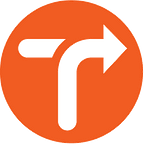The Case for Taxing Large Vehicles
By Justin Tyndall
Over 100,000 pedestrians have been struck and killed by motor vehicles in the U.S. since 2000. The number of pedestrians killed each year has climbed, even as motorist deaths have fallen. At the same time, the average size of vehicles in the U.S. has risen dramatically. While larger vehicles may give the driver a sense of safety, they present a clear risk to other road users, and there is now strong evidence that the ever-increasing size of vehicles is at least partially to blame for the pedestrian death toll. These deaths are utterly unnecessary and preventable, yet policymakers have done very little to address the issue. Policy tools exist to discourage the use of dangerously large vehicles on city streets and isolate pedestrians from their impacts: one efficient policy would be to tax large vehicles and use the revenue to build the infrastructure needed for safer streets.
The link between imposing sizes and increased danger is indisputable: the metropolitan areas in the U.S. that experienced the greatest shift towards larger vehicles have also experienced the greatest increase in pedestrian deaths. If policies existed to discourage large vehicles 20 years ago, and each light truck was replaced by a car, the U.S. would have prevented over 8,000 pedestrian deaths. The largest SUVs and pickups are the most dangerous for pedestrians: they are more likely to hit pedestrians and more likely to be fatal to those they hit. Surprisingly few vehicle models are responsible for a large share of deaths. In 2020, if a pedestrian was killed in a collision on a city street, there was a 12 percent chance that a Chevy Silverado or Ford F-Series truck was involved. When looking at crashes that involved the death of a driver or passenger, the figure was only four percent. Drivers of large vehicles are successfully offloading their risk of death onto other road users. These incentives set up a dangerous arms race wherein drivers seek out the largest vehicles without considering the impact the choice has on other road users.
Moreso than weight, the body dimensions of light trucks likely present the greatest danger to pedestrians. Small vehicles tend to strike pedestrians in the legs, propelling them over the vehicle, while vehicles with higher front-end designs tend to make first contact with a pedestrian’s head or torso, pushing them under the vehicle, and are more likely to cause death.
For any case where one individual’s choice hurts the welfare of others, economists tend to advocate for a tax to adjust incentives. When a factory pollutes, taxing that pollution can reduce emissions to an acceptable level. As compared to outright bans, taxes are an attractive option because they would allow users who place a very high value on owning a large vehicle to continue to do so but compel them to pay for the societal damages of their choice. A tax can be effective regardless of how consumers react, whether consumers avoid the tax by choosing smaller vehicles or pay the tax and continue to drive large vehicles, raising revenue that could be specifically dedicated to improving road safety. Research has shown that properly-designed roads, sidewalks, and crosswalks are likely to be the best solution to deteriorating pedestrian safety. If larger vehicles are here to stay, cities need budgets to properly protect vulnerable road users.
Like conversations around road tolling, taxing large vehicles may cause concerns about the equity of raising revenue from drivers when the design of cities forces most people to drive. However, the largest vehicles also tend to be the most expensive, suggesting that taxing large vehicles would be highly progressive, primarily impacting high-income households. Low-income people and people of color are also less likely to own a car and make up a disproportionate share of the pedestrians and cyclists who are killed on our roads.
The choice to drive an SUV, pickup, or van rather than a car costs society about $100 per year in terms of lost pedestrian life alone and imparts many other costs to society, such as more pedestrian injuries, more motorist deaths and injuries, and higher vehicle emissions due to lower fuel economy. The efficient tax for light trucks is likely several times the $100 figure, and the costs scale up with vehicle size. It’s important to note that these costs — through road deaths, injuries, air pollution, noise pollution, and wear on roads — are currently shared among all taxpayers, including those who cannot afford an SUV. A tax would reduce the societal costs of large vehicles, shift the burden, and raise revenue to further address the problem.
The US already has some examples of charging a tax on large vehicles. At least a dozen states currently factor weight into the cost of registering a vehicle. DC recently proposed a law to raise annual vehicle registration costs to $500 for the largest vehicles. The fees scale up with the size of the vehicle, and revenues will be dedicated to DC’s Safe Routes to Schools program. States and localities should use DC’s program as a model to design their own policies. Assessing a fee as part of vehicle registration offers a convenient option that would confront drivers with the cost of their choice, reminding them that a change in vehicle would be met with savings.
Fixing the pedestrian safety crisis will require both regulating vehicle size and making investments in safer pedestrian infrastructure. A tax on large vehicles, with the revenue spent on street improvements, would help achieve both.
Justin Tyndall is an Assistant Professor of Economics at the University of Hawaiʻi Economic Research Organization (UHERO). He publishes academic research on cities, focusing on the impacts of transportation systems. Justin is particularly interested in understanding how car dependency affects US cities and exploring the impacts of alternative modes of transportation. Justin received his Ph.D. in Urban Land Economics from the University of British Columbia.
